Second Africa Page
11 April 1998
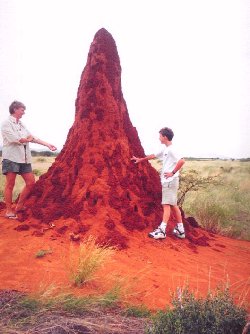 |
Up at dawn this morning for a long drive from
Namutoni to Okaukuego, where we exited Etosha National Park. Then southwest to Swakopmund. Everywhere are giant red termite mounds popping up among the mopane scrub.
Swakopmund is a little piece of Germany set down on
the coast of Namibia, and Deutsche is the language of choice here. It's Easter Weekend and
the only room we can find is at the Bahnhof Casino and Hotel. This big, glitzy complex has
just been created from what remained of the old train station. It is another example of
many similar misguided public works we've seen along the way. In New Zealand, Australia,
the Mascarenes, South Africa, and now in Namibia we've come across these giant, gaudy,
government-built casinos that theoretically will generate revenues for the commonweal. For
the most part they seem quite short of patrons and must be costing a lot to keep open and
maintained.
For the sake of maintaining good relations, Dan and
Kaaren each contributed $20 at the blackjack tables. |
12 April 1998
| As we drove out of town this morning these handsome
Herrero ladies were collecting seaweed, still dressed in their Sunday best. |
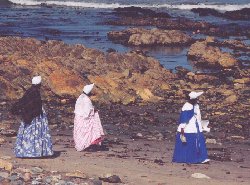 |
Twenty k's south along the coast from
Swakopmund is the town of Walvis Bay. It's a grubby little port city that is a holding of
South Africa, though it lies completely within Namibia. This is our last chance to
provision before heading into the Namib Desert.
 |
The road changed from macadam to gravel at the edge
of town . . . it was the last sealed road we'd drive on for the next 1000 kilometers. The
land quickly becomes parched and barren as we travel south through spectacular red dune
seas and dry, rocky river canyons. We see another vehicle only every hour or so. |
From high up on the escarpment we
spotted a shady lunch spot down in the dry gorge of the Kuiseb River . . . when we got
there we found our spot already occupied by Peter and Kristal Kunstler, whom we'd met days
before at Okaukuego. It was a delightful coincidence and we celebrated with a lunch of
wine, cheese, bread and Oryx biltong.
| We stopped in a little village for petrol. They had
a nice, new-looking gas pump, but no electricity. So the attendant delivered fuel with a
hand-cranked pump. Tyler woke up a little meerkat that was asleep in a shady spot
alongside the station, and fed it some chips. |
 |
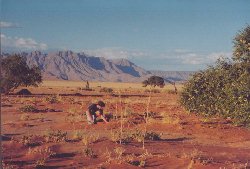 |
A long, hot afternoon later we pulled up to our
little tent-house at the edge of the Sossusvlei dunes. Ty went out at dusk to explore for bugs and birds. |
| Later that evening at dinner we met Bushman (we
never did learn his real name). Bushman is an Afrikaner who grew up on a ranch near
Reitfontein. He's spent his whole life trying to learn the ways and skills of the San
bushmen. We made arrangements with him to guide us on a hiking trip the next morning into
the Sossusvlei dunes. |
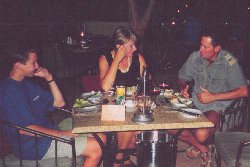 |
13 April 1998
 |
In order to get a headstart on the heat, we were up
and ready to go at 0500. While we were loading up the car a handsome, fortyish-looking guy
dressed in raggedy shorts and old loafers introduced himself as the fourth member of our
group. He asked if he could ride with us for the 50-km drive out to the starting point of
our hike. This is how we got to know a quiet, thoughtful man named Jeannot Krecke. He's a
pretty special person. When we asked him about himself he told us that he's an
ex-professional soccer player, but that he's best known as a sailor and explorer of Arctic
seas . . . only later in the day did he mention in passing that he also happens to be
Majority Leader of Parliament in Luxembourg. He'd come to Namibia to inspect some public
works projects his government has invested in, and took a day off to hike through the
dunes. |
The dunes at Sossusvlei are the highest
in the world, rising over 300 meters above the riverbed where we parked. Except for Polar
Regions, it must be just about the harshest climate on the face of the earth. On the
average, rain falls here only every five years or so. Each organism of this fragile
ecosystem is uniquely adapted to take advantage of what little moisture condenses here
from fog that rolls in from the sea each night. It is so dry that nothing rots when it
dies. If a body is not scavenged, it just desiccates into a dried-up husk that remains
until windblown sand erodes it into invisible bits.
| We started hiking at 0600. The going was sometimes
strenuous: when climbing the dunes, for every two steps taken forward, you slide back one.
Walking through a land so apparently empty of life is unnerving, but at the same time
breathtakingly beautiful. The wind naturally sorts different sizes and colors of sand,
sculpting a pastel landscape into giant sinuous curves and hills and hollows. |
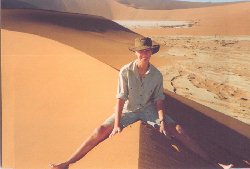 |
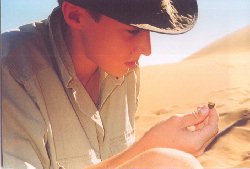 |
At one point we crossed an ancient pan in which
stood the blackened skeletons of camelthorn trees that died of thirst a thousand years
ago. Bushman loves this barren land and knows in minute detail how every plant and animal
fits into its particular niche and is dependent upon the well-being of all the other flora
and fauna in the region. He showed us how perfectly an Oryx turd is 'designed' to provide
the ideal environment for grass seed to germinate when enough moisture is present. |
| By 1100 we got back to where we'd parked, and ate
our breakfast. By then it was starting to get real warm. Bushman drove us to what was left
of a small muddy 'lake' that was all that remained of a tremendous flood that had occurred
several weeks earlier. Probably from the same rains that flooded the Aoub at Etosha,
because here too it was the first time water had flowed in twenty years. People came from
all over Africa to see the phenomenon. |
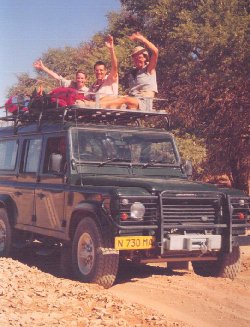 |
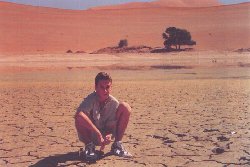 |
The lake developed over a kilometer wide pan that
had been totally desiccated for all those years, and now had again already shrunk to a
muddy wallow. We couldn't get to the water's edge because of the thick, sticky mud, but
even from a distance we could see churning masses of catfish that within a day or two
would be left high and dry. |
| This turned into a very long day. It was afternoon
by the time we said our goodbyes and left Sossusvlei. We'd been hiking through the sand
under a brilliant sun since dawn, and we still had to cover more than 600 kilometers over
unmarked dirt roads to our next destination at Fish River Canyon. Miles from anything that
looked remotely habitable we came across this little family slowly heading somewhere. They
thought we were a pretty odd bunch. |
 |
Despite getting lost a couple of times
we made it to the Fish River Canyon okay, pulling up to the National Park Gates at Ai Ais
a little before midnight. Ai Ais proved to be a total bust. First the guard wouldn't let
us through the gate into the park. Then they had no record of our reservation (we'd paid
in full for the room weeks before). The room they finally gave us was small, old and dirty
and the hot water wouldn't work (and this at a hot springs resort!), the staff was surly
and the food terrible. Don't go there.
Tuesday 14 April 1998
Today is going to be another long one
on the road. We've got over 900 kilometers to cover to get to our next accommodation in
Capetown. Now we're on the main North-South highway, it's macadam and the two-lane road is
in pretty good shape. The official speed limit is 120 kph but is wholly ignored, and most
traffic is going about 150. Even at that speed now and again we're passed by muscle cars
going probably over 200 kph. What's most disconcerting is that a two-lane road is treated
as three lanes, with the centerline conceded to passing traffic. Cars pass anytime they
want, even when confronted with oncoming traffic. If you see a car coming at you, in your
lane, you're expected to make room for them by driving onto the shoulder. It feels like
anarchy on the highway . . . a nonstop game of Chicken. The whole time we were in Africa
we never saw anyone get a speeding ticket.
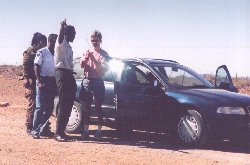 |
Big hassles at the ZAR/Namibian frontier. For some
reason the Namibian border guards decided to pick on us. They went through all our stuff
and made a big stink about us leaving the country with the Himba headdress we'd purchased
in Windhoek. We didn't know if they were shaking us down for a bribe, or what . . . we
wouldn't know how to offer one anyway. We showed them our receipts and documentation, and
finally after an hour of fussing around they sent us on our way. |
Southward to Kapstadt (Capetown).
Next page up is the . . .
Third
Africa Page
dktdavis@aol.com












